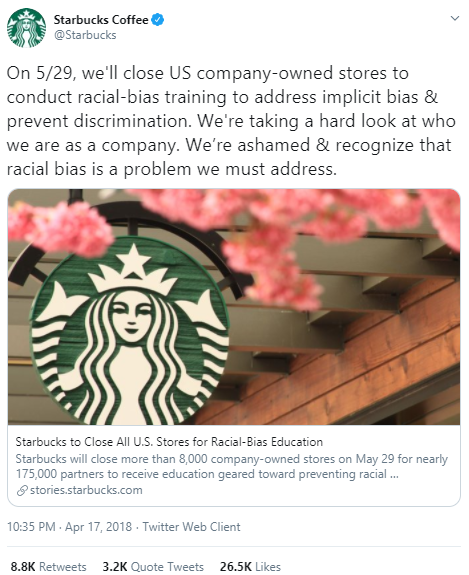A whopping 88% of brand executives view reputation risk as a top strategic business concern, according to a survey by Deloitte.
When a reputation crisis hits your company, you must take action to rebuild your public image. Otherwise, your brand might end up losing market value and plunging into a financial deep hole.
So, how should brand leaders avoid reputational damage that might steer catastrophic events like bankruptcy, liquidation, and insolvency?
This article dives into the brand reputation crisis by providing an eight-step process that you can follow to avert the crisis and rebuild your image.
Brand reputation management after a crisis
1. Analyze the level of damage caused
The first step to take when your brand suffers from a reputation crisis is assessing its severity. This is where you take a step back to analyze the depth of the damage caused.
To understand how serious the situation is, you should quantify changes in corporate reputation, a downtick in perception among employees and stakeholders, and a negative attitude towards the company.
During the initial assessment, it is important to identify any executives or specific brand entities that are directly responsible for the event.
Remember that the brand crisis is reflected online, so keep track of the situation on social media platforms as well as Google search results. You will also need to capture non-media metrics such as sales performance, profitability, and share prices.
Conducting a thorough evaluation of the crisis and its impact on the brand provides the basis for all responses to customer and media inquiries. It is crucial to how stakeholders react throughout the recovery process.
To navigate a corporate crisis successfully, you must have all the data at hand, while carefully separating facts from fiction. All this is what this step involves.
2. Get in touch with key stakeholders and investors
Once you have a clear picture of the current situation, it is time to communicate the impact of the crisis. The first group of people to appease should be major stakeholders in your brand. These include business partners, investors, customers, and other primary stakeholders.
Here, you need to formally provide details of how events unfolded, leading to the crisis. Additionally, let them know what measures you’re taking to resolve the situation. Your ability to bring the company back into alignment rests on how well you can engage key stakeholders.
If you’re looking for reputation crisis examples and how companies dealt with it, look no further. A case-in-point is when Twitter was compromised and accounts of notable public figures used for a cryptocurrency scam in July 2019. Twitter Support informed all affected users as well as the Twitter community what happened and how they’re dealing with the situation before leveraging the press.

Reputation crisis example from Twitter
When informing customers what happened, always strive to remain honest. Otherwise, you will ruin the situation and jeopardize public trust.
In 2011, when Target suffered a major security breach, they tried to downplay the number of credit card details compromised at the beginning, which reduced their credibility when the actual statistics showcasing the real hack were released.
However, when monitoring social media channels, keep in mind that many users have recently moved from Twitter to its alternatives. We have listed the most popular ones in this article.
3. Thoughtfully plan your media communication strategy
The aim of every reputation management strategy after a crisis is to shape public perception. Part of this will involve leveraging the media, where brand leaders issue a public statement and pick the right person to deliver it. This might not be easy as it sounds since you’re defending your brand’s position in the court of public opinion. For this reason, you need to understand the impact of your press release.
In most cases, any of these three situations will apply when communicating with the media.
The first is when your brand is at fault. Here, you need to acknowledge and take ownership of the mistake. An attempt to conceal the truth or deflect blame on another party will only worsen your brand reputation. So, deliver an apology letting the public know that you recognize the failure and that your brand is absolutely committed to resolving the problem.
Another situation is when you’re not at fault. Here, you do not just roll over, take the blame, and deliver a half-hearted apology. The public might perceive your brand as weak, which is equally damaging. Instead, stand up and remain firm to your brand’s position.
The third scenario is when the reputational damage stems from a mistruth published online or by local news outlets. While seeking retraction might seem helpful, it is important to take a more collaborative path by asking the journalist or writer responsible to politely apologize and share the true version. This will promote better understanding and enhance public trust.
Worth a mention is that not every crisis requires you to contact the media. In some situations, you can pull away from media inquiries and only communicate when you can.
4. Focus on strong internal communication
Employees are the best ambassadors your brand has during a crisis. As part of the leadership, you should ensure all employees understand the reputation crisis and why it happened. You should also empower them so that they contribute to alleviating the high-heated situation by embracing corrective actions.
While not every employee can proactively defend your brand, you can start by picking the most enthusiastic and training them.
Other than training, you can provide rewards and incentives for motivation. The ultimate goal is to build a culture where all employees can proactively protect the brand image when a crisis hits.
5. Adjust your social media response plan
Over 65% of business leaders believe that social media can worsen a brand crisis, which is true in today’s socially-driven world. However, you can enhance the restoration process by taking control of your communication platforms. This means taking charge of conversations on your website affiliated blogs, social media channels, review websites, and any other online platform.
As expected, you should publish a formal apology across all these platforms. The apology should be brief and factual. Starbucks did this when apologizing for a racist incident.

Reputation crisis example from Starbucks
Alternatively, you can publish a video of the same where a top executive like the CEO delivers the apology message.
After issuing a statement, you must track all hashtags and keywords that feature your brand. Here, you can use a brand monitoring tool that alerts you whenever online users talk about your brand.
This way, it will be easier to swiftly respond to all comments. Showing the online community that you care about the situation can really pay off when it comes to maintaining good relationships with customers.
When responding to online messages, always remain consistent. You should ensure all subsequent responses reflect your brand position as portrayed in the initial statement.
6. Maintain transparency when handling public issues
Rebuilding your reputation after the crisis is often a battle with all the negative content that blew up your image in the first place. Typically, this involves revising your content, removing content, suppressing damaging content, and publishing positive content relentlessly.
As you deal with content, remember that corporate reputation lies in your delivery, and not your promises. In order for clients to continue working with your brand, they need assurance that you can deal with the current crisis effectively. Here, you must transparently demonstrate how you’re fixing the problem. If you make any promises during the crisis, be sure to fulfill them for the business to survive.
7. Reinstate trust and core corporate values
Trust is one of the defining characteristics of success in today’s corporate world. This is why regaining consumer trust is important for your brand to successfully rebuild its reputation after the crisis. Even if you’ve almost taken full control at this point, you should not relax. Instead, ensure your brand conveys positive aspects such as accreditations, financial stability, longevity, and all positive feedback acquired in the past.
This is an opportunity for the brand to speak in one voice while demonstrating its core values to the public. You should remind customers of the strides the company has taken over the years to attain its current success. The bottom line here is assuring customers of your commitment and showing what measures you have in place to ensure success moving forward.
8. Look into the future
When the PR crisis is over and everyone is feeling relieved and looking forward to returning to normality, remember there’s still one more thing to do. This is planning your brand’s future. The crisis should be an opportunity to assess how you can maintain your brand’s reputation in the long-term.
Warren Buffet once said that “It takes 20 years to build a reputation and five minutes to ruin it.” For this reason, every brand should put in place a concrete plan for ensuring a similar crisis does not occur again.
Amending your internal processes, training employees proactively, and creating a reputation crisis management plan are some steps you can take to protect your brand in the future.
Conclusion
Rebuilding a reputation after a crisis takes a solid strategy, strong commitment, and self-discipline. In today’s highly competitive world, some adversaries will always want to see your brand fall.
However, you shouldn’t let a single brand reputation crisis define your failure. Use the tips outlined above to get your brand’s reputation back in order and come out stronger.
Written by Adela Belin @Writers Per Hour, cover photo by Étienne Godiard on Unsplash

